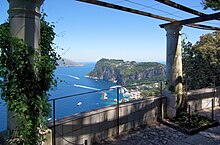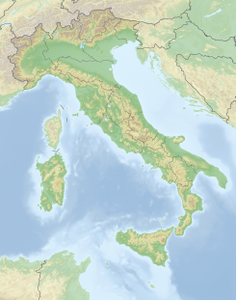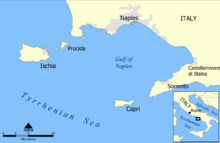capri
| capri | ||
|---|---|---|
| View over the city of Capri with the port of Marina Grande | ||
| Waters |
Gulf of Naples , Tyrrhenian Sea |
|
| Archipelago | Campanian archipelago | |
| Geographical location | 40 ° 33 '0 " N , 14 ° 14' 0" E | |
|
|
||
| length | 6.3 km | |
| width | 2.7 km | |
| surface | 10.4 km² | |
| Highest elevation |
Monte Solaro 589 m |
|
| Residents | 14,204 (2016) 1366 inhabitants / km² |
|
| main place | capri | |
| Map with landmarks | ||

Capri is an Italian rocky island ( limestone ) in the Gulf of Naples . It is 10.4 km² and is known for the caves by the sea. The most famous cave is the so-called Blue Grotto . The highest point of the island is 589 meters above sea level of Monte Solaro . Capri has a balanced, mild climate. The evergreen vegetation is complemented by terrace crops with vine, olive and fruit trees. The main line of business has been year-round tourism since the 19th century. The island is only around five kilometers from the mainland and is part of the metropolitan city of Naples .
geography
The south of Capri is formed by a ridge that breaks off steeply into the Tyrrhenian Sea. The highest mountain is Monte Solaro at 589 m. Other mountains are the Monte Cappello (514 m) north of it, the Monte Tiberio (335 m) on the northeast tip of the island, the Monte Tuoro (266 m) in the southeast and the Monte Michele (262 m) on the northern edge of Capri town. Due to its steep eastern drop, the massif of Monte Solaro and Monte Capello divides the island into a western and an eastern part.
geology
The near-surface geological subsurface consists primarily of limestone that was formed in the Cretaceous period . Due to the limestone, Capri is rich in karst forms . The Blue Grotto, a sea cave, is the best known. In the east of the island there is a natural stone arch.
vegetation
The vegetation on the island of Capri is maquis , which is mainly composed of rosemary and mastic bushes . In places, holm oak forests have been preserved.
Viticulture
White and red wines ( Capri DOC ) are produced on the island , which have had a "controlled designation of origin " (Denominazione di origine controllata - DOC ) since 1977 , which was last updated on March 7, 2014.
- The Capri Bianco is made from at least 80% of the grape varieties Falanghina and Greco Bianco , whereby Falanghina must make up at least 50%. Biancolella grapes suitable for cultivation in the province of Naples can also contribute to the production of this wine, up to a maximum of 20%.
- The Capri Rosso must be at least 80% Piedirosso . A maximum of 20% of other red grape varieties approved for cultivation in the province of Naples may be added.
In 2018, 50 hectoliters of DOC wine were produced on one hectare of vineyards.
history
Archaeological finds from the Grotta delle Felci (fern grotto) are evidence of a settlement on the island since the Paleolithic. Emperor Tiberius chose Capri as his seat of government in AD 26 and spent a large part of the last years of his life there until his death in AD 37 in the Villa Jovis , which lay over a vertically sloping rock. The reasons for this step are controversial among historians. The most important sources for the biography of Tiberius are the ancient writers Suetonius and Tacitus . They claim that the emperor retired to Capri in order to better indulge his desires in seclusion (which Suetonius describes extensively). Perhaps his motive was weariness with government affairs in Rome and distrust of the political forces in the capital. In any case, the small island of Capri was the seat of government of the Roman Empire for eleven years, and this due to a conscious decision of the emperor. Tiberius is said to have owned a total of twelve villas (according to Suetonius) on Capri; today, in addition to Villa Jovis, Villa Damecuta and the so-called Palazzo al mare are Tiberian villas. A city wall in Capri, made of large stones, dates from the 7th century AD to protect against Saracen invasions. The place Capri grew around two medieval town centers. In the north, a district has developed around the Maria delle Grazie chapel since the 11th century . Another district arose in the 13th century around the Case Grandi , the big houses.
Already in the 18th century the Villa Jovis was robbed of its treasures by excavations by the Austrian Norbert Hadrawa and the objects were scattered to the wind (most famous pieces: the so-called “Capri Altar” today in the British Museum in London , and a large mosaic floor in the Museo di Capodimonte in Naples ). Today the Villa Jovis is the most important archaeological sight on Capri. It is located at the eastern end of the island and can be reached in about an hour's walk from the Piazzetta in Capri. Archaeological traces suggest that Tiberius also knew and visited the Blue Grotto .
In the second half of the 19th century, Capri was popular as a winter and holiday resort with German and other artists, writers and other celebrities. We stayed a long time. a. Friedrich Alfred Krupp , Christian Wilhelm Allers , Rainer Maria Rilke , Maxim Gorki , Emil von Behring , Theodor Däubler , Curzio Malaparte , Norman Douglas and Axel Munthe . Ferdinand Gregorovius visited the island in 1853 and stayed for a month. He reported on this in detail. The painters Karl Wilhelm Diefenbach , Hans Paule and Otto Sohn-Rethel lived on the island until their death. German visitors often met at the Hotel Pagano or the restaurant Zum Kater Hiddigeigei . In 1899 the Germans even built their own church, the "German Evangelical Church" on Capri, which still exists today. The members of the foreign colony also laid out their own cemetery: the " Cimitero acattolico ", which still exists today and where over 200 people of non-Catholic denominations were buried.
The island was also a popular meeting place for the futurists in the 1920s , who visited their spokesman Filippo Tommaso Marinetti . Russian exiles were first revolutionaries, then refugees after the revolution of 1905 , who were represented in a very tightly knit colony of emigrants. During his stays in Capri , the focus of these groups was Maxim Gorky , who also wrote his novel “ The Mother ” there. Claude Debussy dedicated one of his most beautiful preludes to the hills of Anacapri (Les collines d'Anacapri). Even Francis Bacon liked to stayed here, and Oskar Kokoschka was several times a guest of Monika Mann , which in the end 1954 Villa Monacone lived on Capri.
Communities
capri
The place extends on the slopes in the central eastern part of the island of Capri. The houses are divided into the central square, the piazzetta , from which the main shopping streets start with Via Roma and Via Camerella. The center and the south of the place are characterized by large hotel complexes. Two roads connect the place with many hairpin bends with the two ports of Marina Grande in the north and Marina Piccola in the south. The Carthusian monastery ( Certosa ) also takes up a large part of the southern center . The connecting road to Anacapri winds around the central mountain range (Monte Solaro) in the north. Capri has 7,132 inhabitants (as of December 31, 2019). Sights in the municipality are:
- Arco Naturale
- Faraglioni
- Giardini di Augusto
- Grotta Matermania
- Via Krupp
- Ruins of the Villa Jovis of Tiberius
- Villa Malaparte
- Baron Fersen's villa Lysis
- Certosa (monastery complex) with Museo Diefenbach
- German Evangelical Church
- San Costanzo Church
- Santo Stefano Church
Anacapri
Anacapri is the main town on the West Island. Main roads lead from there to Punta Carena with the Faro di Punta Carena lighthouse on the southwest corner and to the Blue Grotto in the northwest of the island. Anacapri has 7042 inhabitants (as of December 31, 2019).
Sights (municipality of Anacapri):
- Blue grotto
- Le Boffe
- Monte Solaro
- Villa San Michele (house of the doctor and writer Axel Munthe )
- San Michele Church (1719)
traffic
Driving on the island is only allowed for Caprese people between spring and late autumn. You can take a taxi, use the funicular (a funicular ) or one of the buses.
A chairlift has been leading from Anacapri to Monte Solaro since 1952.
There are many boat connections between the island and the mainland. Large ferries are cheaper than small, fast hydrofoils . The closest port is Sorrento , there are also ferry connections to Naples and Ischia and (less often) to the ports of the Amalfi Coast . The nearest airport is Naples Airport .
gallery
Restored part of Villa Jovis (2005)
The blue grotto from the inside
The Arco Naturale , a natural stone arch on the east coast of Capri
The Via Krupp
Trivia
- A model of the car manufacturer Ford was named after the island of Capri, see Ford Capri .
- The starter salad Caprese was named after the island of Capri .
- Torta Caprese is the name of a chocolate cake in Italy.
- The brand name of the fruit juice drink Capri-Sun was also based on the island.
- The ice cream manufacturer Langnese has been using the name Capri for a fruit ice cream since 1959.
- The German hit " Capri-Fischer " was very popular in the 1950s.
Well-known Caprese
- Raffaele Castello (1905–1969), painter
- Claretta Cerio (1927–2019), writer
- Edwin Cerio (1875–1960), writer
- Ignazio Cerio (1840–1921), naturalist and doctor
- Rosina Viva (1899–1983), painter
literature
- CW Allers : Capri . Hanfstaengl, Munich 1892.
- Claretta Cerio : Capri . Yvonne Meyer-Lohr (Ed.). Prestel Verlag, Munich 2007, ISBN 978-3-7913-3864-4 . (With photographs by Umberto d'Aniello)
- Helge Classen: Longing for Capri . Harenberg, Dortmund 1988, ISBN 3-88379-547-X . (Paperback with many color photos, text by Claretta Cerio .)
- Friedrich Christian Delius , Dieter Richter , Petra Reski u. a .: Once Capri - Always Capri, Capri stories from today. AZUR Verlag, Mannheim 2008, ISBN 978-3-934634-41-1 . (18 authors)
- Werner Helwig : Capri, magical island . Limes. Wiesbaden 1973.
- Humbert Kesel: Capri - biography of an island. Prestel Verlag, Munich 1971, ISBN 3-7913-0007-5 .
- August Kopisch : Discovery of the Blue Grotto on the island of Capri. ed. v. Dieter Richter. Wagenbach, Berlin 1997.
- James Money: Capri, Island of Pleasure . Heinemann, London 1986.
- Hubertus Prince zu Löwenstein-Wertheim-Freudenberg , Capri for connoisseurs . Langen-Müller, Munich 1979, ISBN 3-7844-1724-8 .
- Jana Revedin : Lysis . Wieser, Klagenfurt 2011, ISBN 978-3-85129-906-9 .
- Dieter Richter (ed.): The house of God on the Via Tragara. 100 years of the German Evangelical Church on Capri . La Conchiglia, Capri 2000.
- Jutta Ruocco-Bienengraeber: It all started on Capri. 2nd Edition. AZUR Verlag, 2007, ISBN 978-3-934634-30-5 .
- Stefanie Sonnentag: walks through literary Capri and Naples . Arche-Verlag, Zurich / Hamburg 2003, ISBN 3-7160-2316-7 .
- Axel Munthe : The story of San Michele . Murray , London 1929.
- Ferdinand Gregorovius : The island of Capri - idyll of the Mediterranean. Wolfgang Jess Verlag, Dresden 1952.
- Heinrich Zschalig: The fairy tale island . Fairy tales, legends and other folk poetry of Capri. After oral communication. German book workshops, Dresden 1925.
- Dieter Richter : The island of Capri, a portrait. Verlag Klaus Wagenbach, Berlin 2018, ISBN 978-3-8031-2795-2 .
- Ruth Negendank / Claus Pese: Magic Island Capri. In the footsteps of German-speaking artists , Wienand, Cologne 2018, ISBN 978-3-86832-425-9 .
Web links
- How to get around in Capri (Italian)
- German Evangelical Church on Capri
- Capri motifs on postcards, with descriptions of the island by Ferdinand Gregorovius u. v. a.
- Goethe in distress off Capri
- “Il gabbiano di Capri” is the only German-language magazine about the culture and history of Capri
Individual evidence
- ↑ Disciplinare di Produzione della Denominazione di Origine Controllata (production regulations and description). (PDF) ismeamercati.it, March 7, 2014, accessed September 25, 2019 (Italian).
- ↑ Viticulture in figures 2018. (PDF, 4.8 MB) In: VQPRD d'Italia 2018. Federdoc.com, accessed on September 25, 2019 (Italian).
- ↑ Ferdinand Gregorivus: years of travel in Italy. Agrippina-Verlag, Cologne 1953, pp. 127–153.
- ↑ How to get around on Capri (English)













